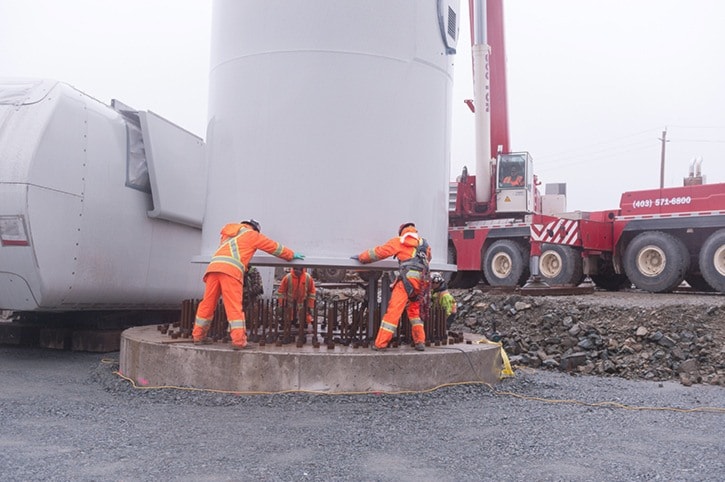KNOB HILL—As one drives northwest from Port Hardy toward Cape Scott over the Holberg and Nahwitti Main roads, the towering cedar, fir and hemlock give way to stunted, gnarled vegetation resembling nothing so much as decorative bonsai trees.
But travel far enough up the road, and the towers return.
Dominating the horizon on the wind-blasted range overlooking the North Pacific near the upper end of Vancouver Island, more than a dozen of the 55 wind turbines of the Cape Scott Wind Farm now stand completed on the 350-hectare site located outside Cape Scott National Park.
And the $300 millon-plus project is on schedule to begin producing renewable wind energy into the Vancouver Island power grid in early October.
"On Oct. 1 we plan to go operational," project manager Brian Arsenault said during a tour of the facility last week. "We expect to send the first power over the transmission lines as early as late August or September."
The company has held a number of open houses to explain the project since notifying the District of Port Hardy and the Regional District of Mount Waddington in late 2011. Arsenault said the public will be welcome to visit and view the wind farm when it is complete, but noted that it is currently an active contraction site and that access is strictly limited for public safety until the farm goes operational.
"When we're finished here, people are welcome to come up and look around," he said. "You can walk right up and put your hand on the towers, if you'd like."
The project, the first undertaken in B.C. by GDF Suez, promises a long-term benefit in 99 kilowatts of renewable wind energy — power enough to to supply 26,000 homes from the current Phase 1 — but also a short-term economic boost to the local economy, with local contractors and labourers among the 250 workers now on site.
GDF Suez estimates an overall economic impact to the local economy of $25 million, though when construction is complete, the project will provide only 12 permanent operations and maintenance positions.
"We're at peak employment now," said Arsenault, who noted a laundry list of local firms contracted for work including — but not limited to — Port Hardy Bulldozing, Rock Pro, Three Nations Construction, Nigel Parr Contracting, Pacificus Biological Service, Strategic Forest Management and OK Tire.
The Cape Scott project has proven to be a huge engineering challenge for GDF Suez, which currently has operational wind farms on Prince Edward Island, in New Brunswick and in Ontario and additional sites under development in Nova Scotia, New Brunswick, Ontario, Manitoba, Saskatchewan and Alberta.
None of them has provided the unique challenge of North Vancouver Island's terrain, said Arsenault, a native of Atlantic Canada who has previously worked in the far north.
"After being approved for construction, the first six or seven months were spent just getting the road system in place," said Arsenault.
Wind turbine components, built in China and shipped to the Port of Nanaimo before being trucked to the North Island, could reach the wind farm site only after substantial road-building work was undertaken. After leaving a staging yard in Port Hardy, tower sections, turbine blades, hubs and nacelles — the boxy unit containing the many motors and electrical components — travel the Holberg Road to the Nahwitti Main. The Nahwitti, a twisting, up-and-down logging road, had to be substantially altered with levelling, bridge-building and bank-cutting to accommodate the 50-metre-long blades and tower sections.
And Nahwitti Main did not even reach the edge of the wind farm.
"We built 33.4 kilometres of new road," Arsenault said. "We put in four bridges on Nahwitti and 22 more bridges on the wind farm site."
Upon the project's infrastructure completion, crews will have installed 27 bridges, 67 imbedded culverts and 500 cross-drain culverts.
Cape Scott Wind Farm is made up of far more than the imposing wind turbines. It will boast its own power sub-station, an office and warehouse complex, and numerous collector lines feeding into what will be a 40-kilometre transmission line into Port Hardy's power substation.
